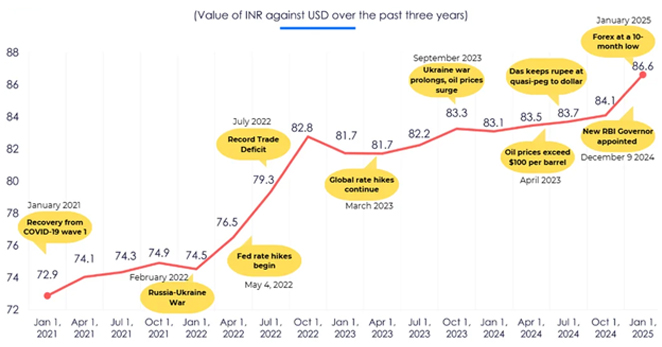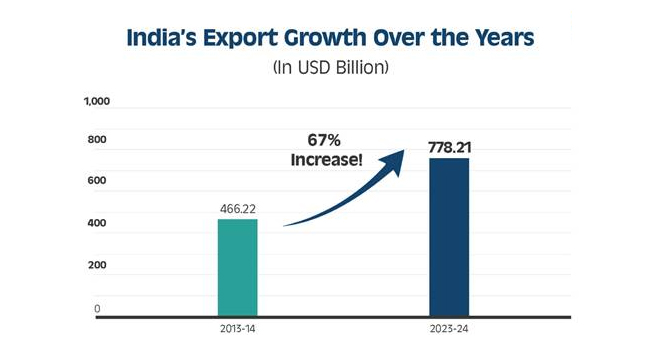
US President Donald Trump recently announced sweeping reciprocal tariffs that have caused significant disruptions in global markets. As a result, India is facing a 26% tariff on its exports to the United States. This decision is part of Trump’s broader “Liberation Day” trade policy, which imposes new tariffs on over 180 countries, including major economies such as China, the European Union, and India.
The immediate market reaction has been negative, with Dow Jones Futures tumbling 1.5% and India’s Gift Nifty falling sharply in anticipation of a bearish opening. But what does this mean for the Indian stock market, key sectors, and the broader economy? Let’s break it down.
Key Highlights
- A universal 10% baseline tariff on all imports
- Country-specific reciprocal tariffs are set at half of what each nation charges US goods
- Special 25% duties on automobile imports
The 26% tariff comes at a critical time for India, which recorded a $36.8 billion trade surplus with the US in the last fiscal year. Key exports to the US included electronics (15.6% of total exports), gems and jewelry (11.5%), and pharmaceuticals (11%). These new tariffs pose a threat to the balanced trade relationships that India has worked hard to establish.
Immediate Market Reactions

Financial markets reacted swiftly to the news. In overnight trading, Gift Nifty futures – a key indicator for Indian market openings – dropped 1.5%, signaling a rough start for domestic stocks. The rupee faces renewed pressure as foreign investors grow wary of emerging market exposure.
Sectorally, analysts predict the hardest hits will come to
Automobile exporters like Tata Motors and Samvardhana Motherson face the double whammy of general tariffs plus special 25% auto duties. These companies derive significant revenue from US sales and could see margins compressed.
Pharmaceutical firms with substantial American exposure may need to rethink pricing strategies. While India’s generic drug makers have been US market staples, higher tariffs could make their products less competitive against domestic manufacturers.
Electronics and hardware exporters face similar challenges. With electronics representing India’s largest export category to the US, companies in this space may need to absorb costs or risk losing market share.
Impact on FDI and NIFTY

The newly imposed tariffs are expected to negatively impact foreign direct investment (FDI) in India. As export-driven sectors encounter increased trade barriers, global investors may become reluctant to invest in industries that heavily depend on trade with the United States. This hesitation could lead to a slowdown in FDI inflows, particularly affecting sectors such as manufacturing, IT, and pharmaceuticals, where foreign capital is essential.
NIFTY is expected to face a 2-3% decline as investor sentiment weakens. Key sectors likely to be affected include:
- Automobile sector: A potential 5-7% drop, as companies struggle with increased costs and reduced competitiveness.
- Pharmaceutical sector: A 3-5% dip, with concerns over pricing pressures and reduced market share in the US.
- IT & Electronics sector: A 4-6% decline, particularly in hardware companies exporting to the US.
The extent of the impact will depend on how businesses and policymakers respond in the coming weeks.
Beyond the Immediate Shock

While the initial market reaction is clearly negative, several factors indicate that the long-term impact may be less significant.
- India’s vulnerable exports make up only 1.1% of its GDP, which is a relatively small portion of the overall economy. This offers some protection against the most severe consequences.
- The “half-rate” nature of the reciprocal tariffs allows for potential negotiation.
- India has been gradually diversifying its export markets, with increasing trade flows to Europe, Africa, and Southeast Asia, which has helped reduce dependence on the United States.
The Road Ahead

The coming weeks will be critical as policymakers and businesses adapt. Key developments to watch include:
- Diplomatic negotiations: India will likely push for exemptions or phased implementation
- Corporate responses: Will exporters absorb costs, raise prices, or shift markets?
- Currency movements: A weaker rupee could partially offset tariff impacts
- Investor sentiment: FPIs may remain cautious until the full impact becomes clear
This creates both risks and opportunities. The initial market panic may create attractive entry points in strong companies oversold due to tariff fears. However, selectivity will be crucial – businesses with high US exposure may face prolonged headwinds.
One thing is certain in an era of renewed trade wars: volatility is the new normal. As the situation develops, market participants would do well to stay informed, remain flexible, and keep a close eye on both macroeconomic trends and company-specific fundamentals.
VT Markets provides traders with a robust platform & necessary tools to trade in uncertain conditions. Whether you’re looking to hedge against currency fluctuations or capitalize on new opportunities arising from shifting trade dynamics, VT Markets helps you with advanced trading technology and expert market insights.
The full impact of Trump’s tariff revolution remains to be seen, but for Indian markets, the message is clear: buckle up for a bumpy ride.







